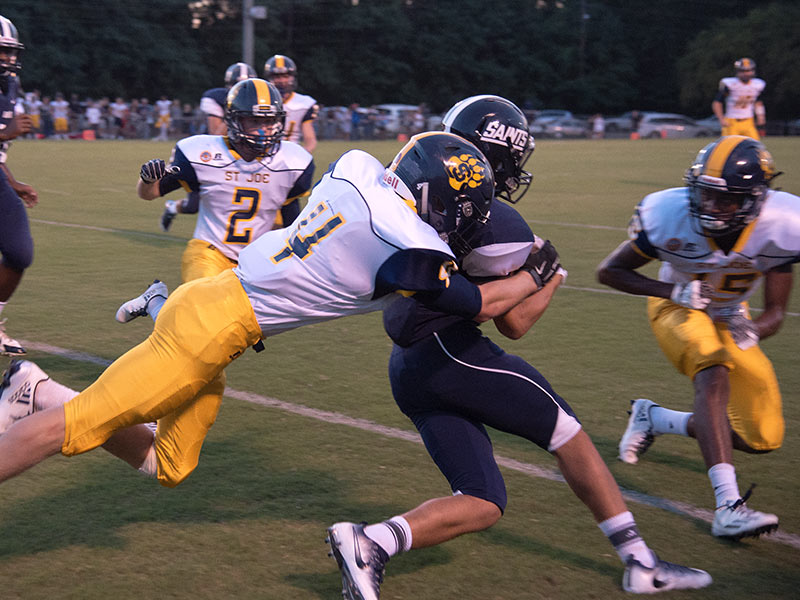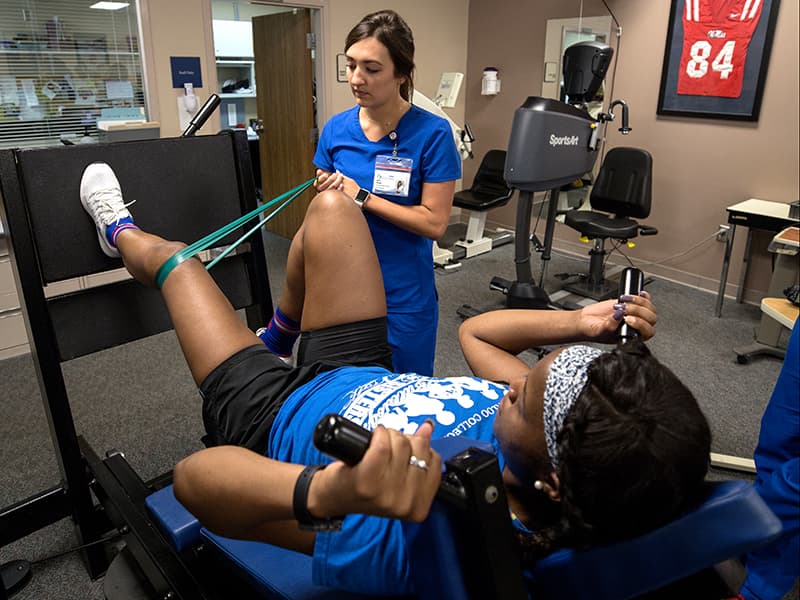If it’s fall in Mississippi, it’s the season for sports-related injuries

When athletes get hurt, there’s a fairly short list of common injuries that come into play.
Chief among them: ankle sprains, muscle strains, concussions, shin splints and knee injuries such as anterior cruciate ligament tears and meniscal tears.
“The end of July going into August is when football cranks up, and there will be a lot of football-related injuries over the next three to four months,” said Dr. Jim Hurt, assistant professor of orthopaedic surgery at the University of Mississippi Medical Center. “Soccer follows that, and then basketball. The majority of injuries in the younger population in those sports will be knee injuries.”
Although some student-athletes with traumatic injuries or broken bones are seen at UMMC’s Emergency Department, the most common thing Department of Orthopaedics and Emergency Medicine physicians treat is knee injuries, said Hurt, whose specialty is sports medicine. “It’s pretty epidemic among young people, and a lot of it (is) related to lower extremity weakness and muscular imbalance.”

Research shows about 70 percent of ACL tears occur in females, and most of them are non-contact injuries. An athlete who is running might stop suddenly or cut directions.
“But the knee continues to go, and the ACL can tear,” Hurt said.
Such tears can be traumatic and painful, he said.
“A student will feel a pop in their knee, and the knee basically dislocates. Most people know something is wrong right away, and it tends to swell significantly.”
If an ACL tear is suspected, he said, a parent should ice the knee and bring his or her child to an orthopaedic or primary care doctor immediately during the workday or to an emergency department after hours.
“If you’re not sure about it, getting attention sooner than later is better,” he said.
Ankle sprains and muscle pulls also are common, Hurt said.
“We see a lot of kids whose ankle rolled or was stepped on,” he said. “Typically, if you can’t walk on it within a day or so, there’s a high risk that you broke something and need to seek medical attention.”
He suggests parents and students follow a “RICE” procedure: rest, ice, compression and elevation.
“If that doesn’t make it better in the next couple of days, you need to get it checked out and get X-rays to make sure there’s not a fracture.”
Many young athletes have muscular imbalance and lower extremity weakness. There are numerous exercise programs and ACL prevention programs that work to decrease their chance of injuries, Hurt said.
“They can increase your mind’s ability to know where your knees and lower extremities are in space, and they can decrease your muscle imbalance.”
If a child takes a hard hit to the head and reports blurry vision or ringing in his or her ears, it could be a concussion.
“Act on the extreme end of caution,” Hurt said. “They will be pulled out of play. Often, the trainer at the game is the first one to evaluate them. If there’s any question, they should be held out, and we call it a concussion.”

UMMC runs a postgame high school sports medicine clinic from 9-11p.m. every Friday night during football season in the orthopaedic suite at University Physicians Pavilion. It’s a resource for metro-area parents who want their children examined right away for game injuries that are not traumatic, Hurt said.
The clinic is staffed by UMMC sports medicine experts who give free initial examinations to any athletes needing attention. X-rays and physical therapy services also are available. Examples of conditions treated include suspected concussion, bumps and bruises, broken bones, ligament and ACL tears, and tendon tears.
“We can wrap their knees and ankles, get them crutches and get X-rays to confirm injuries,” Hurt said. “We can set up an MRI to be done the next day, or that Monday. It expedites their care.”

“What’s also great about the clinic is that it brings a multitude of sports medicine experts together to examine and communicate with the injured athlete and their parents,” said Jeff Martinez, the Medical Center’s supervisor of sports medicine.
“Everyone on our team is able to offer their expertise at the same time, rather than having the patient come back to see different specialists. The physician can give a diagnosis, the physical therapist can offer some at-home therapy for the weekend, and the athletic trainer can prepare treatment and rehab plans to begin on Monday at the athlete’s school.”
The goal is for athletes whose injuries aren’t extreme to be treated at the clinic instead of an emergency room, where wait times can vary. Even if a serious condition isn’t detected, a prompt medical exam can bring peace of mind to a student and family. Walk-ins are welcome, but if possible, call ahead at 601-815-4721.
“The clinic also helps coaches prepare their teams for the coming weeks,” Martinez said. “By getting injury status and care started sooner, coaches are better able to begin planning for the upcoming games.”
Mississippi is lucky to be a state where football is king, Hurt said. Almost every school has a physician, a skilled athletic trainer or both on the sidelines. UMMC staffs between five and 10 metro-area football games each Friday of the season.
“For a lot of kids, this is the most exciting time of their life,” Hurt said. “Athletics is very important to them. They might not play college ball, but they will tell their grandchildren about playing football when they were in high school.
“Anything you can do to expedite their care and get them back on the field is good for them.”
The American Academy of Pediatrics offers several tips for parents that can help keep their student-athletes injury-free:
- Give the student breaks that will allow his or her body to recover. Plan to have at least one day off per week and at least one month off per year from training for a particular sport.
- During a game or sporting event, take breaks, especially to avoid heat illnesses. Wear light clothing and drink plenty of fluids before, during and after exercise or play. And when it’s very hot and humid, decrease or stop practices or outdoor competitions.
- Make sure student-athletes are wearing the right gear and that it fits. This includes protective equipment such as pads, helmets, mouthpieces, face guards, protective cups and protective eyewear. Protective gear doesn’t ensure children won’t be injured, especially when they are involved in more dangerous or risky activities.
- Emphasize strengthening muscles by performing conditioning exercises during practice.
- Increase flexibility by stretching after a game or practice and as part of a daily fitness routine.
- Teach children proper techniques and reinforce them during the playing season.
- Play safe. There are strict prohibitions against a number of moves, such as head-first sliding in baseball or softball, spearing in football and checking in hockey. Insist such rules are enforced.
- No matter what, do not play through pain. It can greatly exacerbate an injury.


